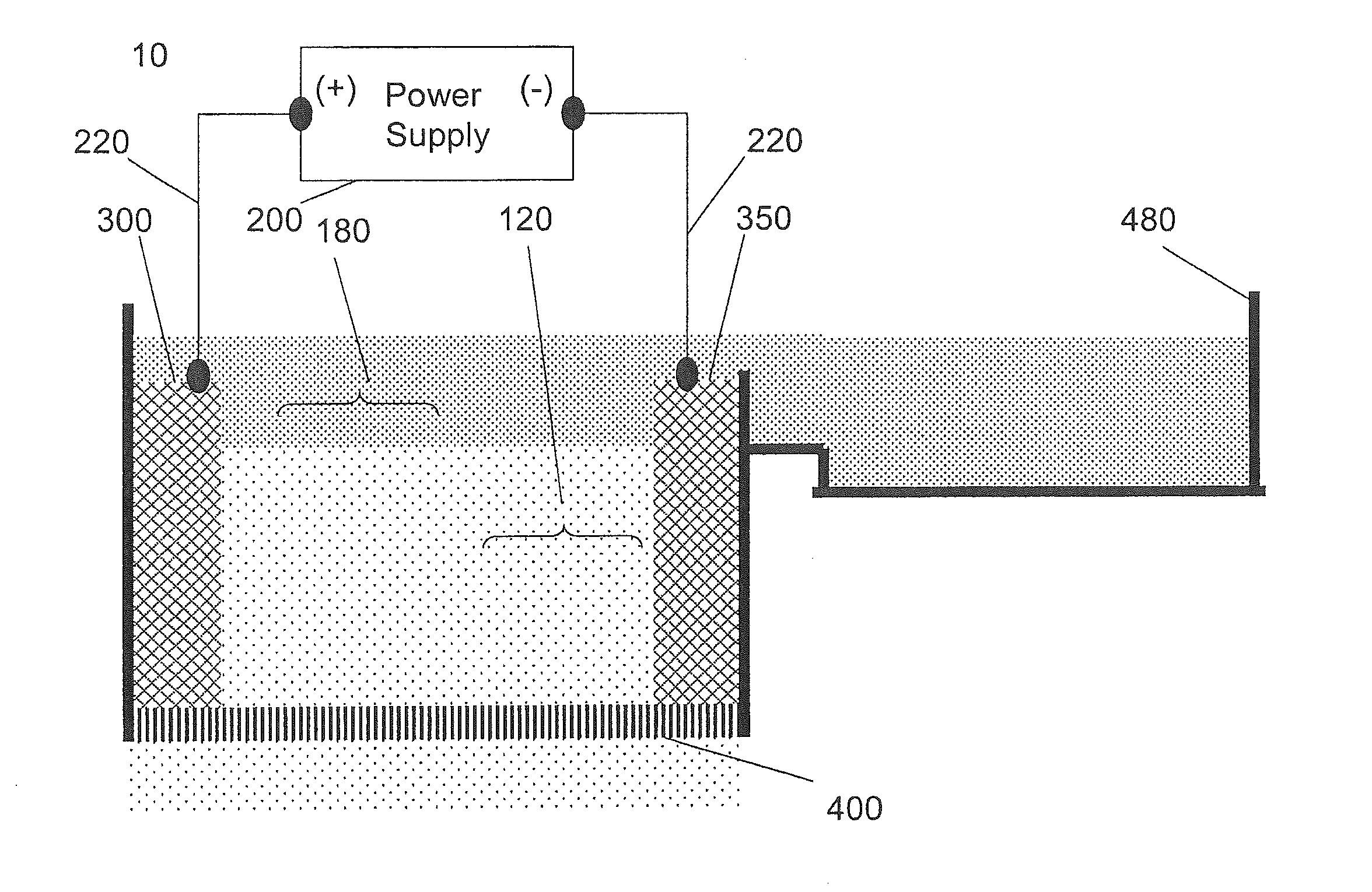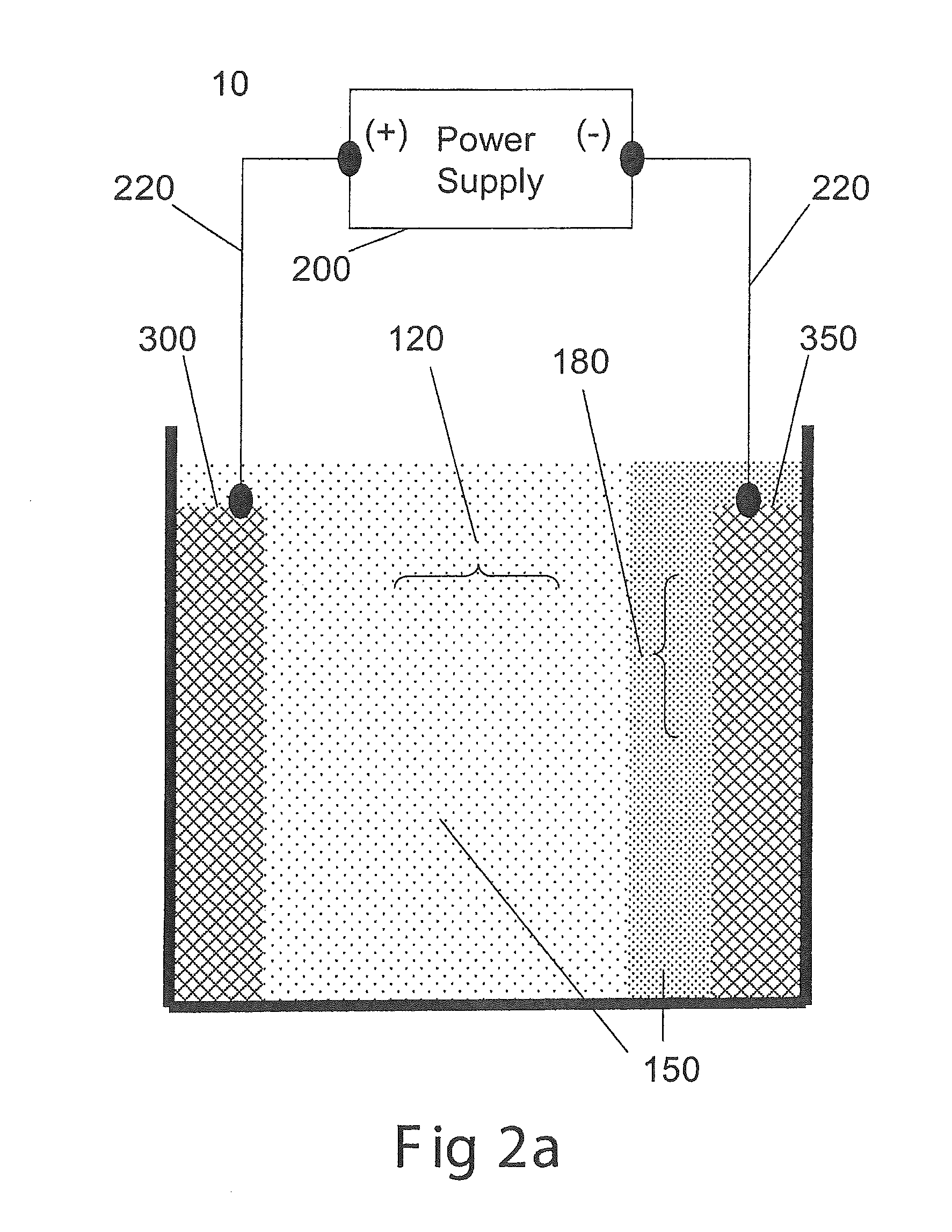Electrolytic system and method for filtering an aqueous particulate suspension
a technology of aqueous particulate suspension and filtration system, which is applied in the direction of fluid pressure measurement, liquid/fluent solid measurement, peptide measurement, etc., can solve the problems of limiting the usefulness of bioreactors, so as to minimize the blockage of the filter medium or eliminate the effect of blocking
- Summary
- Abstract
- Description
- Claims
- Application Information
AI Technical Summary
Benefits of technology
Problems solved by technology
Method used
Image
Examples
example 1
[0046]The applied voltage was 50V DC with an initial current of 1,300 mA and a final current of 3,000 mA. The voltage was applied for 10 minutes. During the experiment, vigorous electrolysis was observed and the algae collected as a floated mass at the top of the solution. Due to the vigorous electrolysis, the floated algae mass could not be collected and accurately measured for cell count. During the course of the experiment, the container became very hot. The region between the electrodes was visually very clear and cell count indicated that this region was depleted by 181.9 times compared to the initial algae concentration. The energy consumption per volume was calculated as 204 W·hr / L of solution. The water consumption was calculated as 45.5 μL water / L solution (4.56 μL water / (L solution·min)).
example 2
[0047]The applied voltage was 50V DC with an initial current of 1,300 mA and a final current of 2,000 mA. The voltage was applied for 2 minutes. During the experiment, vigorous electrolysis was observed and the algae collected as a floated mass at the top of the solution. Due to the vigorous electrolysis, the floated algae mass could not be collected and accurately measured for cell count. The region between the electrodes was slightly green and cell count indicated that this region was depleted by 7.8 times compared to the initial algae concentration. The energy consumption per volume was calculated as 28 W·hr / L of solution. The water consumption was calculated as 31.8 μL water / L solution (15.9 μL water / (L solution·min)).
example 3
[0048]The applied unidirectional pulsed voltage was 50V PC with a duty cycle of 20% and a frequency of 100 Hz. The initial current was 1,220 mA and a final current of 1,400 mA. The voltage was applied for 4 minutes. During the experiment, minor electrolysis was observed and the algae collected as a floated mass at the top of the solution. The floated algae was collected and the cell count indicated the algae was concentrated by 31.5 times compared to the initial algae concentration. The region between the electrodes was slightly green and cell count indicated that this region was depleted by 12.8 times compared to the initial algae concentration. The energy consumption per volume was calculated as 0.8 W·hr / L of solution. The water consumption was calculated as 0.16 μL water / L solution (0.04 μL water / (L solution·min)).
[0049]Although various aspects of the disclosed electrolytic concentration method and apparatus for the concentration of suspended algae from a solution have been shown...
PUM
| Property | Measurement | Unit |
|---|---|---|
| Fraction | aaaaa | aaaaa |
| Fraction | aaaaa | aaaaa |
| Electric potential / voltage | aaaaa | aaaaa |
Abstract
Description
Claims
Application Information
 Login to View More
Login to View More - R&D
- Intellectual Property
- Life Sciences
- Materials
- Tech Scout
- Unparalleled Data Quality
- Higher Quality Content
- 60% Fewer Hallucinations
Browse by: Latest US Patents, China's latest patents, Technical Efficacy Thesaurus, Application Domain, Technology Topic, Popular Technical Reports.
© 2025 PatSnap. All rights reserved.Legal|Privacy policy|Modern Slavery Act Transparency Statement|Sitemap|About US| Contact US: help@patsnap.com



